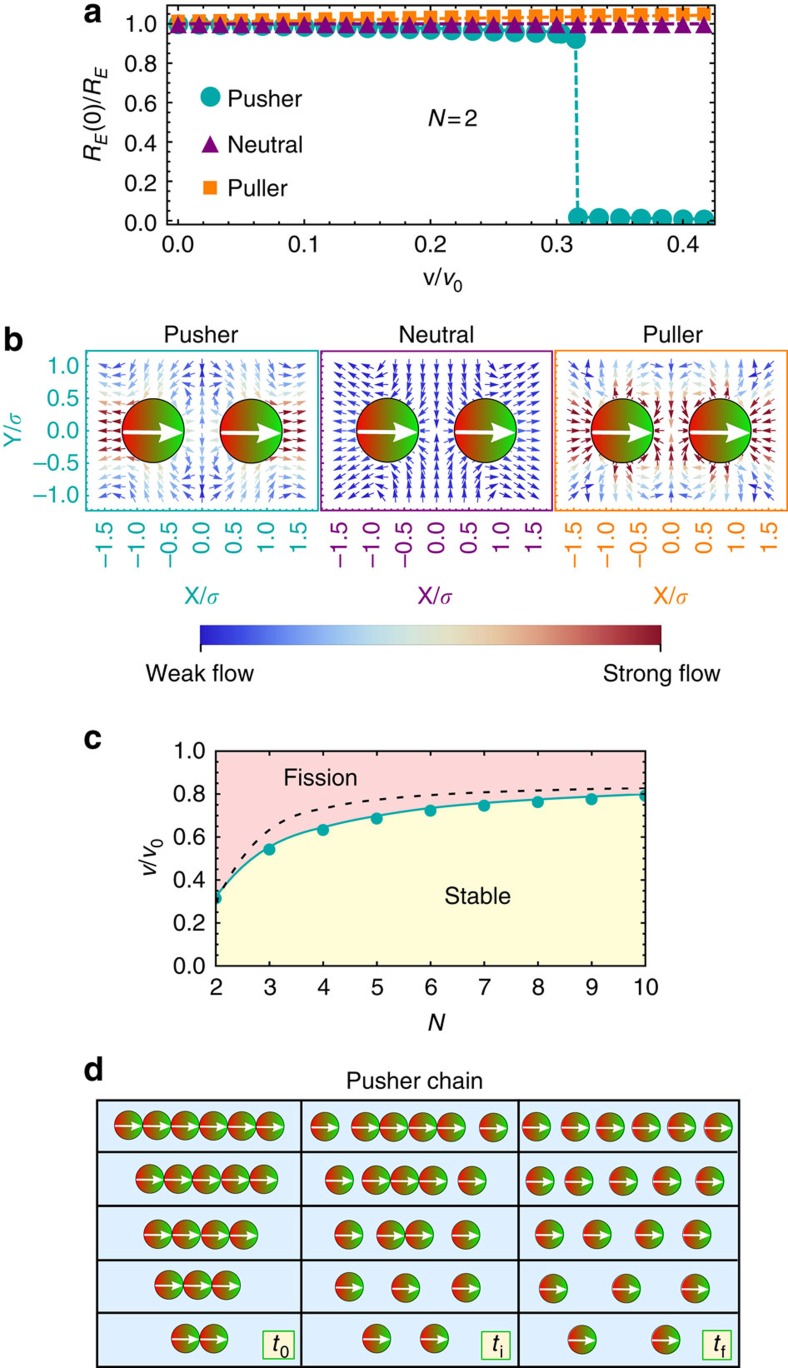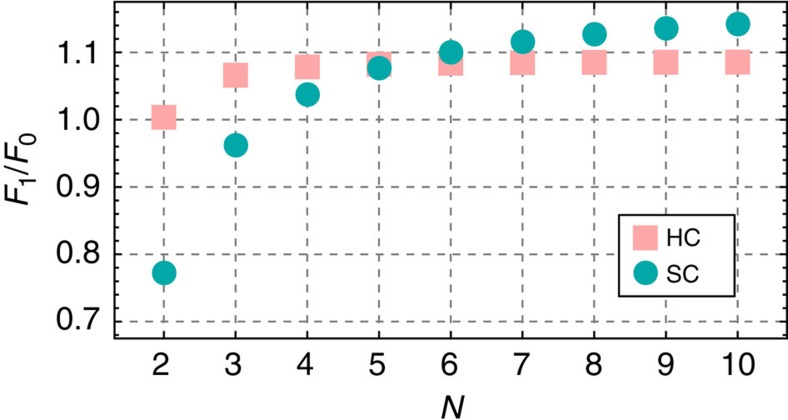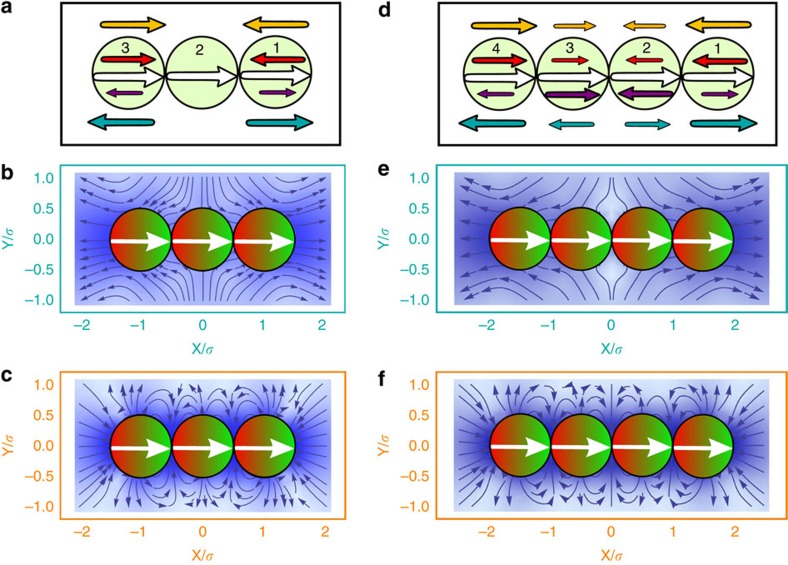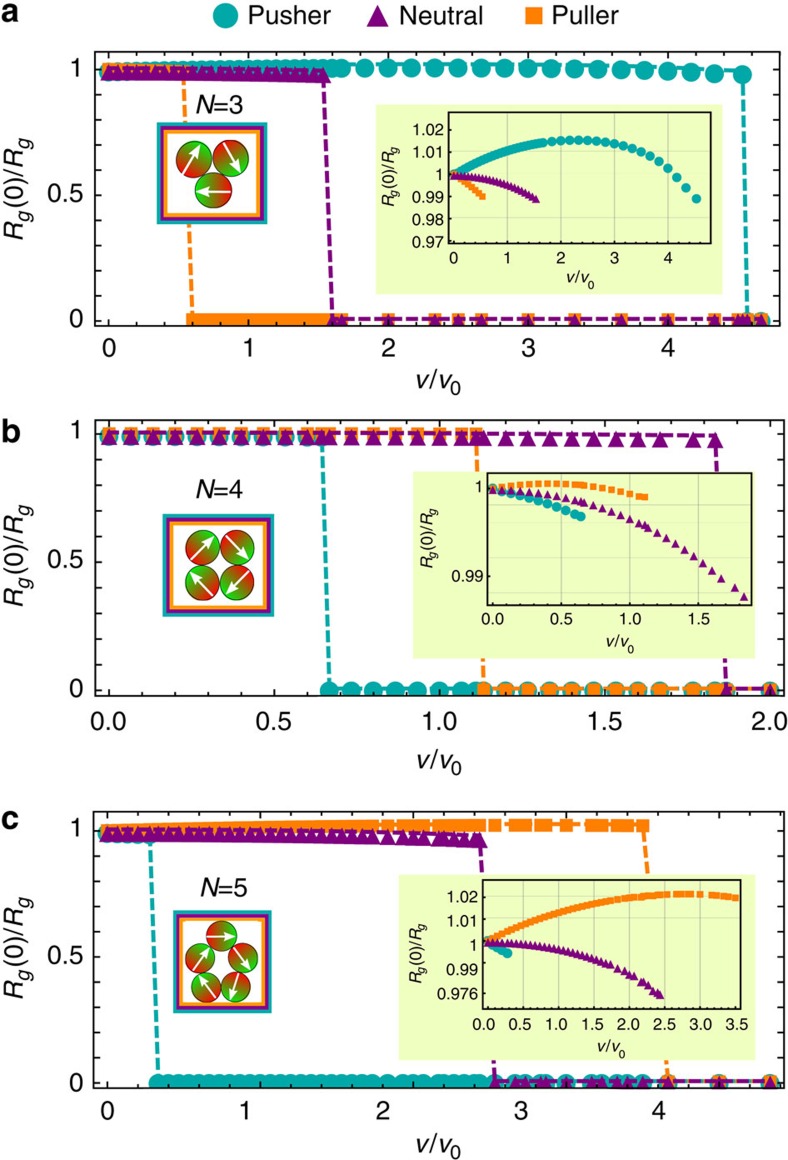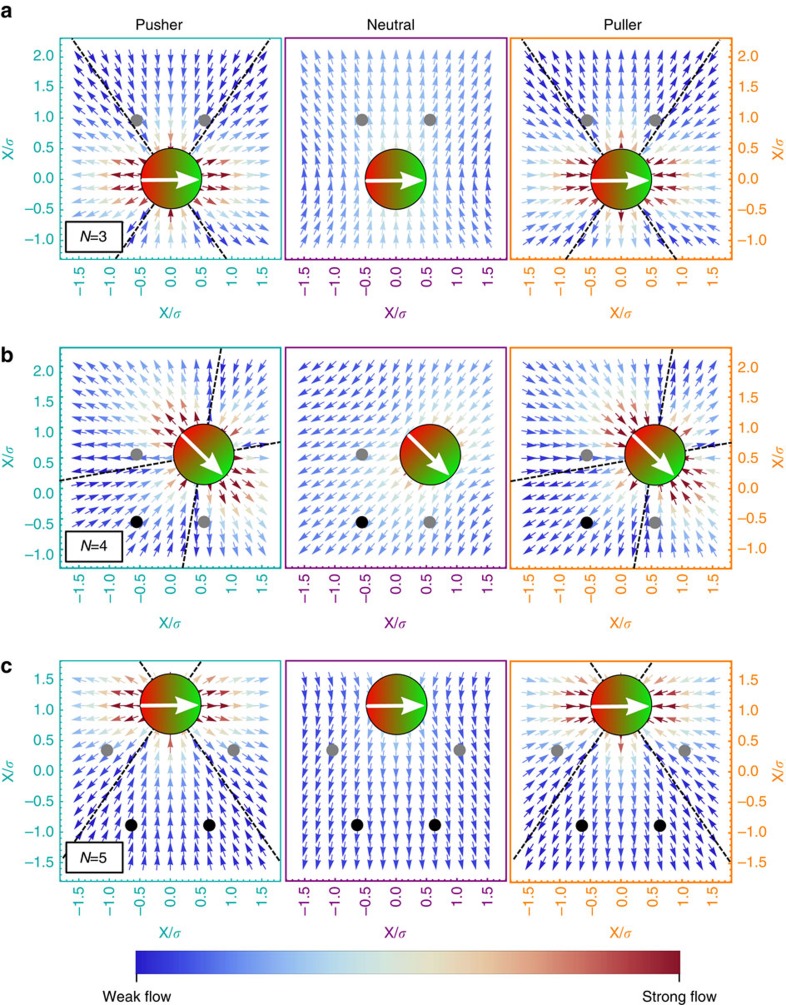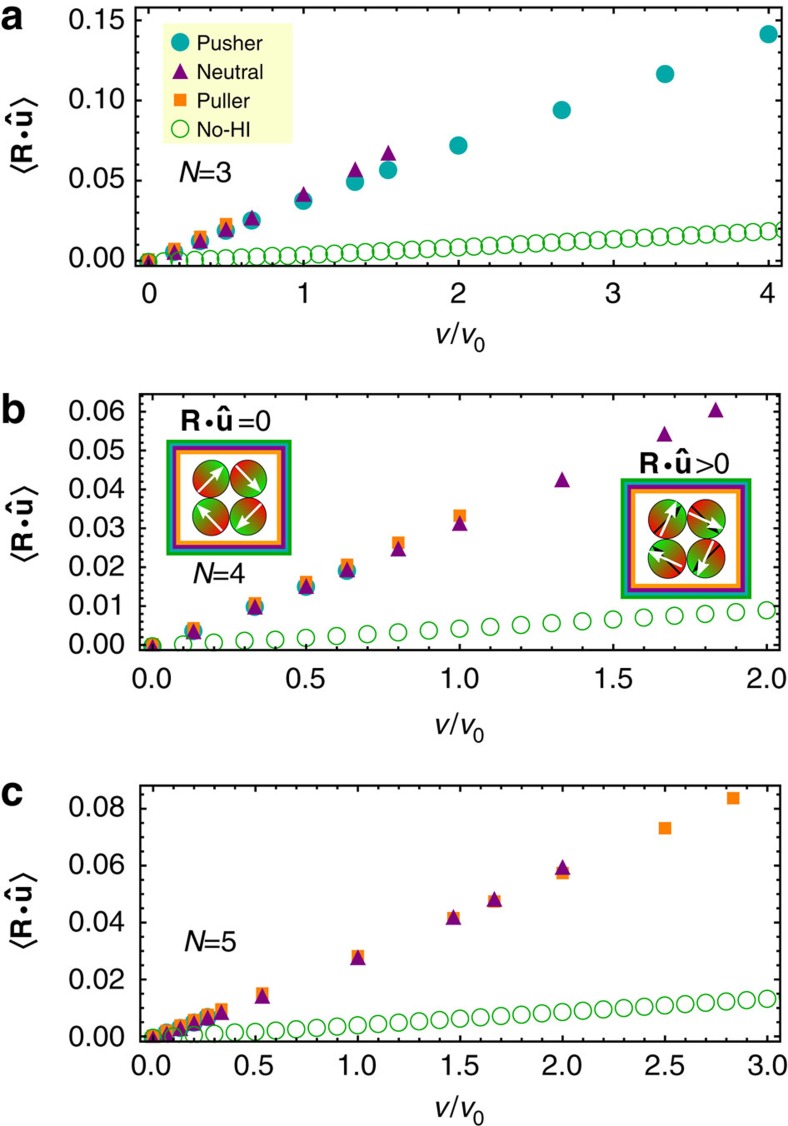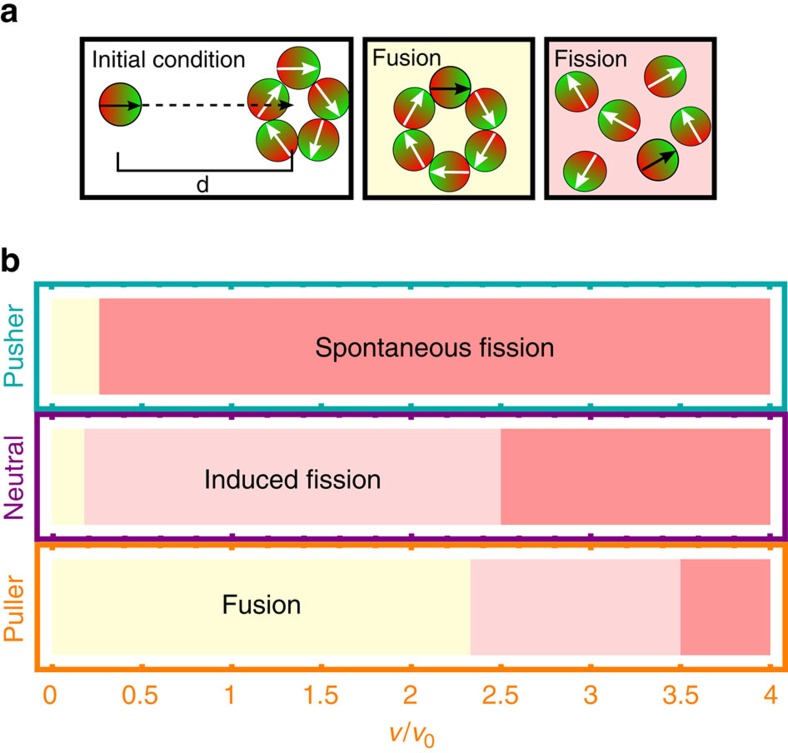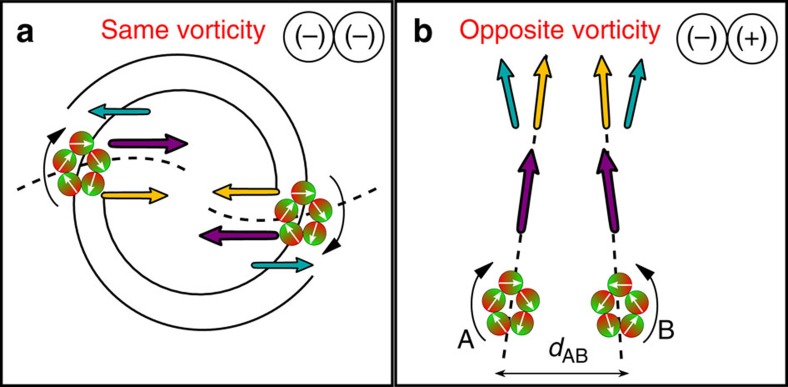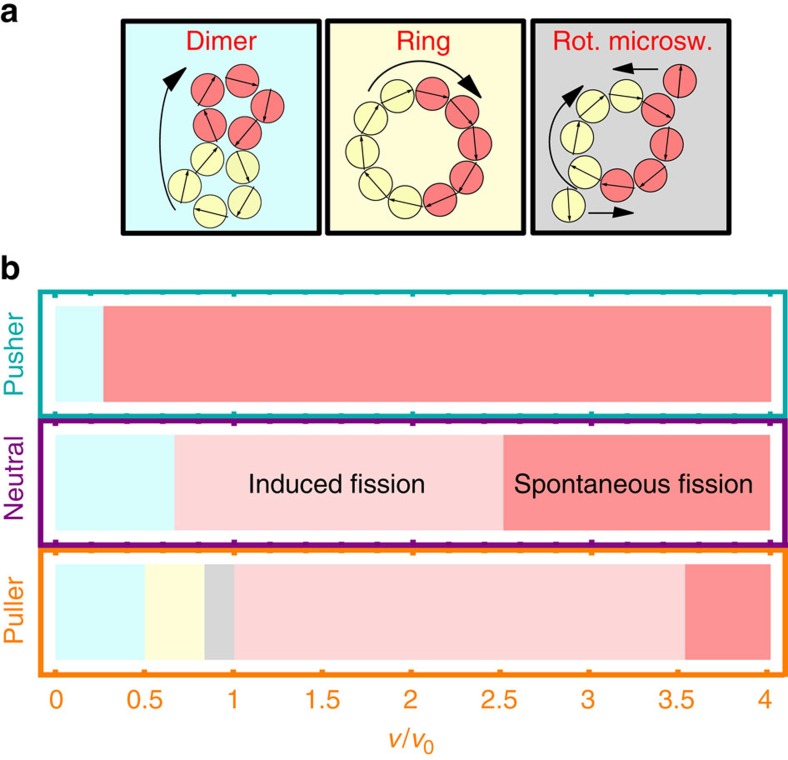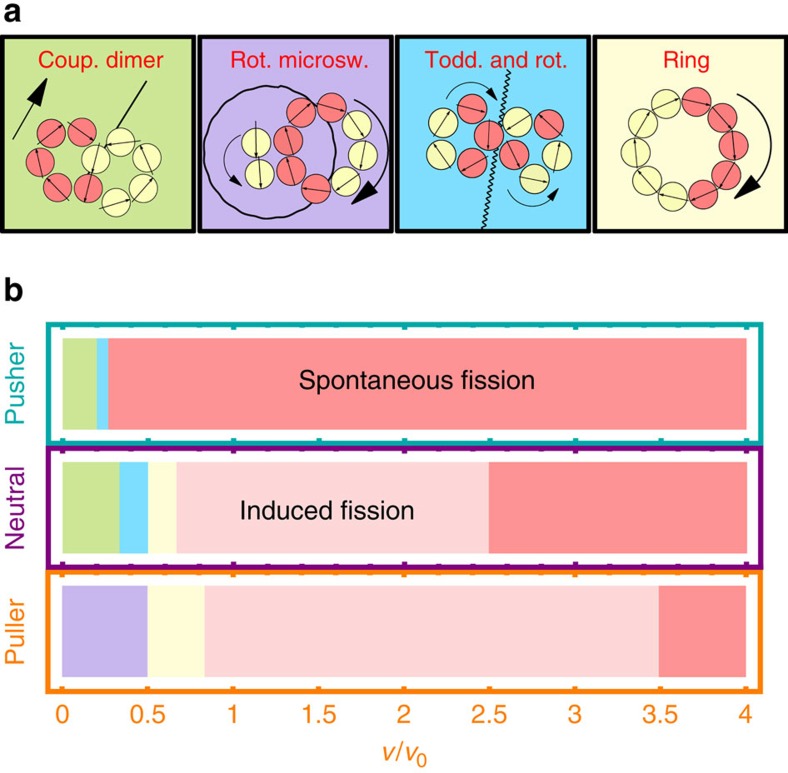Abstract
Fission and fusion processes of particle clusters occur in many areas of physics and chemistry from subnuclear to astronomic length scales. Here we study fission and fusion of magnetic microswimmer clusters as governed by their hydrodynamic and dipolar interactions. Rich scenarios are found that depend crucially on whether the swimmer is a pusher or a puller. In particular a linear magnetic chain of pullers is stable while a pusher chain shows a cascade of fission (or disassembly) processes as the self-propulsion velocity is increased. Contrarily, magnetic ring clusters show fission for any type of swimmer. Moreover, we find a plethora of possible fusion (or assembly) scenarios if a single swimmer collides with a ringlike cluster and two rings spontaneously collide. Our predictions are obtained by computer simulations and verifiable in experiments on active colloidal Janus particles and magnetotactic bacteria.
 The collective motion of microswimmers is determined by not only their direct interaction, but also the hydrodynamics forces mediated by the surrounding flow field. Here, the authors detail in simulation the spontaneous assembly and disassembly of magnetic microswimmers into various structures.
The collective motion of microswimmers is determined by not only their direct interaction, but also the hydrodynamics forces mediated by the surrounding flow field. Here, the authors detail in simulation the spontaneous assembly and disassembly of magnetic microswimmers into various structures.
Many phenomena in physics, chemistry and biology are governed by fission and fusion of particle clusters. These processes occur on widely different length and energy scales ranging from subnuclear to astronomic. Examples include the large hadron collider1, nuclear fission and fusion2, splitting and merging of atomic and molecular clusters3,4,5, micron-size colloidal particles6,7, cells8 and macroscopic granulates9 up to clustering in planetary debris disks10. Fission and fusion can either happen spontaneously or be induced by a collision with another particle or entity. The fission and fusion processes provide valuable insight into the interactions and dynamics of the individual particles and are a promising pathway to fabricate new types of composite matter on the various scales.
In the past decade microswimmers have been studied extensively. These active soft matter systems consume energy and are, therefore, self-propelled out-of-equilibrium autonomous systems. The interactions between many of those swimmers are either direct body forces or hydrodynamic ones as mediated by the solvent flow field created by the swimming motion. The latter depend on the details of the swimming mechanism and can be classified as either neutral, pushers or pullers11,12. An important example for the former are magnetic dipole moments that enable to actuate and control the swimming path by an external magnetic field13,14,15,16,17,18,19,20. In the absence of swimming, the structure of two-dimensional21,22 and three-dimensional23,24 dipole clusters has been explored recently, but the impact of activity on a swimmer cluster has been rarely studied25. Recent simulation studies26,27 have revealed that the mean cluster size crucially depends on the strength of the self-propulsion speed. Moreover, it has been shown that activity itself28,29,30,31 and chemotaxis32,33 can induce clustering28,29,30,31. Hence, though the structure of microswimmer clusters have been widely studied, the process of induced and spontaneous fusion of such clusters is unexplored except for spontaneous fission of swimmers clusters where all hydrodynamics was neglected. Furthermore, the impact of hydrodynamic interactions (HIs) has not yet been studied for magnetic dipole swimmers.
In this communication, we explore both spontaneous and induced fission and fusion processes for magnetic microswimmer clusters. These processes may also be referred to as disassembly and assembly. We do this for the two basic swimmer classes pushers and pullers. The details of the HIs governing whether the swimmer are pushers, neutral or pullers12,34,35,36. Pushers and pullers can be described as dipole swimmers whose flow fields are similar, but with opposite flow patterns. While pushers push fluid away from the body along their swimming axis and draw fluid in to the sides, pullers pull fluid in along the swimming direction and repel fluid from the sides. This has important consequences for the interactions between swimmers and give rise to qualitatively different fission and fusion scenarios, which we classify for small particle clusters. In detail, we study the spontaneous fission processes for two chosen types of clusters, linear chains and rings, representing the ground state of magnetic dipoles21,24. While linear chains remain stable for pullers and neutral swimmers they are split in the case of pushers. However, ring-like clusters show fission events in any case independent on the details of the HI. A single swimmer hitting a ring cluster can end up in spontaneous and induced fission or in fusion. Finally, two fusing ring clusters reveal a wealth of complex joint dynamical modes. We use computer simulation techniques to obtain our predictions, which are in principle verifiable in experiments on active colloidal Janus particles and magnetoctactic bacteria.
Results
Spontaneous fission of a chain
Let us start using the simplest structure of a cluster—a one dimensional chain of N dipolar particles with a fixed dipole moment m, where all magnetic moments possess the same orientational direction aligned along their separation vector. So the total magnetic moment  is M=Nm for all chains, which coincides with the ground state for small numbers of particles24. By applying a self-propulsion velocity v, directed along the dipole moments, to each single dipolar particle, a joint motion of the linear chain will emerge. Using the inverse of the end-to-end distance
is M=Nm for all chains, which coincides with the ground state for small numbers of particles24. By applying a self-propulsion velocity v, directed along the dipole moments, to each single dipolar particle, a joint motion of the linear chain will emerge. Using the inverse of the end-to-end distance
 |
where ri=[xi, yi, zi] is the coordinate of the ith particle, we study the spatial extension of the chain for varied self-propulsion velocity v, see Fig. 1a for the case of N=2, whereby, RE(0) depicts the value for a passive chain and RE is measured after a sufficiently long simulation time t to establish steady-state structures. While in the absence of HIs no changes in the chain conformation are observed37, we identify three different behaviours for magnetic microswimmers. (i) Pullers, generating a contractile flow field, shrink the chain, RE(0)/RE>1, (ii) neutral swimmers hardly affect the configuration of the chain, RE(0)/RE≥1, and (iii) for pushers, generating an extensile flow field, the chain swells, RE(0)/RE<1. This even leads to fission of the chain RE(0)/RE→0, for reduced self-propulsion velocities v/v0≥0.32, where v0=2m2/πησ5 is the corresponding drag velocity caused by the magnetic dipole–dipole interaction for two aligned and touching dipoles, with diameter σ, in a head-to-tail configuration. This observed behaviour is the result of the super-positioned flow field of the microswimmers, which is contractile for pullers and extensible for pushers, see Fig. 1b.
Figure 1. Stability of microswimmer chains.
(a) Relative end-to-end distance RE for all three HI cases and varied velocity v for fixed N=2. (b) Flow fields for a chain of N=2 magnetic microswimmers for (left) pushers, (middle) neutral swimmers and (right) pullers. The magnitude of the flow is indicated by the colour coding of the arrows, weak flow is indicated by dark blue and strong flow by dark red arrows. (c) Emerging state diagram spanned by reduced velocity v/v0 and number N of particles within a chain of pushers marking two distinct regions; stable chains for small and fission for large self-propulsion velocities. Numerical results (cyan line) obtained for soft sphere dipoles are compared with those for hard sphere dipoles (black dashed line). (d) Time series indicating the fission process for the cases N=2, …, 6, showing the initial configurations at time t0, the configuration after the first fission event at an intermediate time ti and the final steady state configuration of N individual particles at time tf, see also Supplementary Movies 1 and 2.
The state diagram for chains of pushers spanned by the applied self-propulsion velocity v and the number of microswimmers N within a chain is shown in Fig. 1c. This diagram reveals two distinct regimes. For low velocities the chain remains stable, while large self-propulsion velocities lead to a fission. The fission process for chains of pushers happens stepwise as can be seen in the time series sketched in Fig. 1d and in the Supplementary Movies 1 and 2. The extensile flow field generated by pushers leads to a repulsion of the particles within the chain. Beyond a certain critical velocity, the chain of N particles will split into three different units—a remaining chain of N−2 pushers and repelled head and tail particle. To understand the symmetric stepwise mechanism we will address below the behaviour of the critical velocity leading to fission, as well as an analysis of all acting forces within a chain.
Let us now focus on the behaviour of the critical velocity leading to fission as a function of number of swimmers before we discuss the fission process itself. We have already shown that the extensile flow of the pushers can lead to fission although the particles are attracted due to their dipole–dipole interaction. By considering the total acting magnetic force on the head particle of a chain F1, we can observe that the magnitude of the magnetic attraction grows with increasing chain length N. Here we compare the cases of soft magnetic dipolar particles with hard sphere dipoles. In Fig. 2, the force on the head particle F1 is normalized by F0=6m2/σ4, where σ is the respective length scale provided by the hard core potential or the used Weeks-Chandler-Anderson (WCA) potential38. The force F0 is the force due to the dipole–dipole interaction if a particle pair is in a head-to-tail configuration with a central distance σ. Hence for a larger number of pushers in the chain higher self-propulsion velocities are necessary to split the chain. As a remark, we add these data to Fig. 1c as a dashed line, leading again to differences that are caused by the softness of the pair potential.
Figure 2. Magnetic dipole forces.
Reduced total magnetic dipole–dipole force acting on particle 1, F1/F0, in a chain cluster as a function of the number of dipoles N. The squares represents the analytical results for hard sphere dipoles. The circles represents the numerical results for soft-spheres using the WCA-potential, as shown in Fig. 1c. Note that the scale F0 depends on the potential, see text for details.
To determine why the chain splits in the middle, we focus on all acting forces on the microswimmers within a chain. Due to symmetry, torques are excluded for all chains and for the middle microswimmer in a chain with an uneven number of swimmers, the only unbalanced force is the force due to self-propulsion, see Fig. 3a. The two ends are attracted by the dipole–dipole interaction and repelled by the Stokeslet. While for pullers there is a further attraction of the particles in the end of the chain, the extensile flow field generated by pushers lead to a further repulsion—which is proportional to the self-propulsion velocity v. Hence, beyond a critical velocity vc the chain of N≥3 particles will split into three distinct units, two individual swimmers and a remaining chain of N−2 swimmers, see again Fig. 1d. This remaining chain will show further fission events, since the critical velocity increases with an increasing number of particles, see again Fig. 1c.
Figure 3. Acting forces and flow field around chains.
(a,d) Acting forces in a chain of N=3 and N=4 microswimmers. The arrows indicate direction and magnitude of all acting forces: self-propulsion force (white), force due to magnetic dipole–dipole interaction (red) and the basic HI due to the Stokeslet (purple). In case of pushers, the extensile flow leads to an repulsion (cyan) and in case of pullers the contractile flow leads to an attraction (orange arrows). Resulting flow field for a linear chain of (b) N=3 and (e) N=4 pushers as well as for (c) N=3 and (f) N=4 pullers using the same colour coding as in Fig. 1b.
Spontaneous fission of a ring
Now we consider the dynamical behaviour of an isolated ring-like cluster for different numbers of microswimmers N=3, 4 and 5 with vanishing total magnetic moment M=0 (refs 9,25,40). The activity of each particle leads to the formation of a cluster, which rotates with a constant angular velocity ω around the non-moving center of mass. The angular velocity depends on the magnitude of the self-propulsion velocity37.
To study the fission of such a ring-like cluster, we analyse the self-propulsion velocity dependence of the inverse radius of gyration Rg for the final configuration of the cluster, with respect to the initial radius of gyration Rg(0) for a passive cluster, see Fig. 4. The radius of gyration Rg is defined by
Figure 4. Stability of microswimmer rings.
Inverse radius of gyration Rg(0)/Rg as a function of self-propulsion velocity v for ring-like clusters with a given number of swimmers: (a) N=3, (b) N=4 and (c) N=5. Insets: (right) close up the the radius of gyration and (left) sketches of the initial configurations.
 |
where  is the center of the cluster. If each particle is attributed a fictive unit mass, this center can be interpreted as the center of mass. However, in the case of low Reynolds numbers, it is more appropriate to interpret it as the center of velocity. While Rg(0)/Rg>1 indicates shrinking, Rg(0)/Rg<1 implies swelling of the ring-like cluster. In the extreme case of fission, the inverse radius of gyration vanishes, Rg(0)/Rg→0.
is the center of the cluster. If each particle is attributed a fictive unit mass, this center can be interpreted as the center of mass. However, in the case of low Reynolds numbers, it is more appropriate to interpret it as the center of velocity. While Rg(0)/Rg>1 indicates shrinking, Rg(0)/Rg<1 implies swelling of the ring-like cluster. In the extreme case of fission, the inverse radius of gyration vanishes, Rg(0)/Rg→0.
Figure 4 shows that for ring-like clusters with N=3, 4, 5 magnetic microswimmers all swimmer types show a diverging radius of gyration, so fission, for large self-propulsion velocity. Previous studies without HIs have shown that ring-like clusters are stable for all self-propulsion velocities37. However, the critical velocity to achieve fission as well as the general behaviour of the inverse radius of gyration strongly depends on the swimmer type and on the respective number of swimmers in the cluster. The fission of rings is a combined result of a swelling of the ring-like structure and a change in the orientation of the dipoles within the rings—with increasing velocity they point outwards, an effect which is enhanced by HIs.
Let us start with a ring-like cluster of N=3 microswimmers. Figure 5a shows the flow field of a single microswimmer and indicates the position of the two other particles within the ring by grey dots. While these additional particles are attracted in case of pushers, the neighbouring particles are repelled in case of neutral swimmers and pullers. Hence the rings show the expected shrinking and swelling behaviours, see again Fig. 4a. The velocity dependence of the inverse radius of gyration for pushers is non-mononotic. This is a result of an induced torque on each particle, Fig. 6a, which leads to a ring configuration where the dipoles point outwards. This state is non-favorable for magnetic dipoles and, therefore, even pushers show a swelling behaviour for velocities v/v0>2.7.
Figure 5. Flow-field of a single swimmer within a ring-like cluster.
Flow field generated by a single (left) pusher, (middle) neutral swimmer and (right) puller. Dots indicate the positions of nearest (grey dots) and next nearest neighbours (black dots) for (a) a ring-like cluster of N=3, (b) N=4 and (c) N=5. The dashed lines indicate the transition from inwards to outward flow. The magnitude of the flow is indicated by the colour code varying from dark blue (weak flow) to dark red (strong flow).
Figure 6. Alignment of dipoles within a ring-like structure.
Alignment of the swimmer within a ring-like chain measured by the product of the swimmers orientation  and R=ri−rcv for (a) N=3, (b) N=4 and (c) N=5 swimmers.
and R=ri−rcv for (a) N=3, (b) N=4 and (c) N=5 swimmers.
Ring-like clusters of N=4, 5 pushers and pullers show the opposite shrinking/swelling behaviour as rings of N=3 particles, see Fig. 5b,c. For pushers, the position of the nearest neighbour are now in the repulsive regime of the flow field, while the nearest neighbours of a pusher are attracted. As before the ring contracting for small self-propulsion velocities, shows a non-monotonic inverse radius of gyration as a function of velocity, see Fig. 4b,c, caused by the weaker magnetic attraction of the misaligned dipoles, see Fig. 6b,c.
The fission velocity for rings of pullers and neutral swimmers is monotonically increasing as a function of number of swimmers in the ring, while it is non-monotonic for pushers, see Supplementary Fig. 1 for the fission state diagram for rings.
Induced fission and fusion
Let us now study the fusion scenarios of a ring-like cluster if it collides with a single swimmer. Initially, this swimmer approaches the center of velocity of the ring, here we choose a ring of N=5 swimmers, whereby all swimmers have the same self-propulsion velocity, see Fig. 7a. As long as the ring-like cluster does not show any spontaneous fission the initial set-up leads to an induced collision. In Fig. 7b, we summarize the resulting states for pushers, neutral swimmers and pullers and varied the self-propulsion velocity for these collision events.
Figure 7. Induced fission and fusion.
(b) State diagram of the emerging scenarios for all three swimmer types and varied reduced self-propulsion velocity v/v0 and respective snapshots, if a single swimmer collides with a ring-like cluster, see also Supplementary Movie 3. The initial set-up as well as the emerging characteristic structures are sketched in panel a.
As seen before large self-propulsion velocities will lead to a spontaneous fission of the ring-like clusters for all swimmers. If the initial ring-like cluster is stable and the single swimmer collides with the rotating ring, two different scenarios can be observed. Either the single swimmer fuses with the ring, creating a new stable ring of N+1 particles (see Supplementary Movie 3), or the impact leads to an induced fission into various fragments of different size and shape. While the induced fusion emerges for all considered types of microswimmers, the induced fission does not occur for pushers due to the instability of the initial ring beyond a self-propulsion of v/v0>0.3.
Spontaneous fusion of two ring-like clusters
Spontaneous pattern formation and pair interaction of rotating particles and vortex arrays, has been aroused a lot of interest in the past few years, in experiments39,40,41 and in theory42,43,44,45 revealing the importance of the HI in this type of systems. It has been proved that magnetic rotors at finite Reynolds number exhibit pattern formation and hydrodynamic repulsion, while a pair of interacting rotors in the Stokes limit exhibit hydrodynamic attraction.
In this section, we will consider a pair of rings A, B with N=5 particles with an initial distance dAB. Due to the self-propulsion of the individual swimmers the rings can be treated as active rotors42. While the center of velocity for an isolated ring is non-motile, a pair of rotors/rings interact via the long-range HI leading to a cooperative motion of their centers of velocity. The actual characteristics of this motion depends on the vorticity of the ring-like cluster: For opposite vorticities the HI leads to a linear translation of the pairs, while for the same vorticity the rotors propagate on a spiral42,43,44.
Let us start by considering rotors with the same vorticity. Ring-like clusters composed of neutral swimmers approach each other on bended lines, see dashed lines in Fig. 8a. For large self-propelled velocities v/v0>0.5 the spiral trajectories, in the case of pullers and pushers, correspond to predictions for active rotors with higher-orders in the mutipole expansion42. The centers of velocity of the individual rings propagate on shrinking (puller) or expanding (pusher) spirals, see Fig. 8a. In this case, we have the contribution of the two mobility terms in the motion equation (see equation (5)), that leads to a radial (Stokeslet) and an azimuthal (rotlet) contribution in the cycled-averaged flow field for large distances dAB≫Rg. Here it is important to notice that in our case we have a non-zero torque on each particle due to the dipole–dipole interactions, this makes our problem different from the past studied cases42,43.
Figure 8. Schematic trajectories for two rotating ring-like clusters.
(a) Two ring-like clusters A, B of N=5 swimmers each, rotating with same vorticity and an initial distance will approach while propagating on a spiral, while pushers may repel each other. Dashed lines show the trajectories of the individual centers of velocity for neutral swimmers. The coloured arrows indicate the direction of the acting forces due to hydrodynamic interactions, as in Fig. 3. (b) For rings rotating with opposite vorticity, the clusters will approach each other for all microswimmer types. Their respective centers of velocity move on straight lines. For pushers it is possible that the rings move apart from each other at larger velocities.
As a result, ring-like clusters of pullers or neutral swimmers will approach each other and collide, while rings of pullers would repel each other for self-propulsion velocities v/v0>0.5. However, this velocity is beyond the fission velocity of a single ring, therefore, we never observed this behaviour for rings of N=5 pusher. Note that ring-like clusters composed of N=3 and N=4 pushers have shown the expected propagation42,43 for self-propulsion velocities v/v0>0.5. For the velocities that allows stable rings, v/v0<0.3, they behave similar to neutral swimmers. This threshold, v/v0∼0.5, is determined by the velocity dependence of the contractile flow profile.
Figure 9 shows the emerging states after the encounter between the two rings for all microswimmer types. As expected from the center of velocity trajectories, we observe fusion scenarios for small self-propulsion velocities for all swimmers. For pushers in the velocity range 0≤v/v0≤0.27, the two rings will collide and stick together but not change their shape—this conformation will be referred to as a dimer (Supplementary Movie 4). Due to the vorticity of the individual rings the dimer will still rotate. The same structure can be found for neutral swimmers (0≤v/v0≤0.67) and pullers (0≤v/v0≤0.5). As shown before large self-propulsion velocities destabilize the rings and spontaneous fission is observed. However, neutral swimmers and pullers exhibit even more distinct emerging states. While the neutral swimmers just show a collision induced fission for self-propulsion velocities 0.67<v/v0≤2.5, pullers exhibit two different fusion states. For self-propulsion velocities 0.5<v/v0≤0.8, the two rings fuse into a single ring with N=10 particles (Supplementary Movie 5). As a last state, we find a state with two counter-rotating microswimmers close to a ring of N=8 pullers for 0.8<v/v0≤1. These two counter rotating microswimmers are trapped by the superposition of hydrodynamic and dipole–dipole interactions (Supplementary Movie 6).
Figure 9. Spontaneous fusion and fission for ring-like clusters with the same vorticity.
(b) Emerging states for all the swimmers types as a function of reduced self-propulsion velocity v/v0—see Supplementary Movies 4–6. Different states are indicated by different colours and fused states are sketched in panel a and characterized as: (i) a spontaneously fused rotating dimer, (ii) an emerging closed ring of N=10 swimmers, (iii) a closed ring of N=8 swimmers with counter rotating microswimmers, (iv) induced fission into various fragments and (v) spontaneous fission of the individual initial ring-like clusters.
Now, we focus on rotors with opposite vorticity. For opposite vorticity pullers and neutral swimmers show converging lines in the full range of velocities. While we would find diverging lines for pushers for v/v0>0.5, we could not observe this due to the spontaneous fission above v/v0≥0.27 for rings of N=5 pushers. Ring-like clusters composed of N=3 and N=4 pushers have shown the expected propagation42,43 for self-propulsion velocities v/v0>0.5. For velocities that guarantee stable rings of pushers behave similar to rings of neutral swimmers and approach each other on converging lines, see Fig. 8b. For the corresponding velocity regime the contribution due to the mobility terms are larger, in the far-field, compared with the activity terms in the equation of motion (see equation (10)). Therefore, clusters of all swimmers types will collide even if they have opposite vorticities.
For pushers in the regime 0≤v/v0≤0.2, we observed an emerging coupled dimer, see Fig. 10 (Supplementary Movie 7). Here the two rings are coupled and translate together on a linear path in the absence of any global rotation. For larger velocities, 0.2<v/v0<0.3 the rings can exchange particles and moves with a complex combination of toddling and rotation (Supplementary Movie 8). Neutrals swimmers exhibit the same two states, coupled dimer for v/v0 ≤ 0.33 and the toddling and rotation state for 0.33<v/v0≤0.5. In addition to that the fusion into one ring containing all particles is possible for 0.5<v/v0≤0.67. Below the critical velocity for the spontaneous fission of an individual ring, the neutral swimmers exhibit some collision induced fission into various fragments of different size and shape. In contrast to pushers and neutral swimmers, the collision of two ring-like clusters of pullers show the fusion into a single ring and the induced fission as well show a new conformation. The new state, 0<v/v0≤0.5, shows a ring of N=8 pushers and a chain of two swimmers orbiting around the ring against its direction of rotation (Supplementary Movie 9).
Figure 10. Spontaneous fusion and fission for ring-like clusters with opposite vorticity.
(b) Emerging states for all swimmer types as a function of reduced self-propulsion velocities v/v0—see Supplementary Movies 7–9. Each state is depicted in a sketch in panel a and can characterized by: (i) a non-rotating but translating coupled dimer, (ii) a counter rotating microswimmer chain orbiting around a ring of N=8 swimmers (iii) toddling and rotation, where the former rings exchange swimmers and translate, (iv) an emerging ring containing all N=10 swimmers as well as (v) collision induced and (vi) spontaneous fission of the ring-like clusters.
Discussion
In conclusion, we have introduced the concepts of spontaneous and induced fission and fusion for clusters of magnetic microswimmers and exemplified these processes by studying linear chains and rings upon increasing the self-propulsion as well as ring–ring collisions. A wealth of dynamical processes governed by the excluded volume, magnetic dipole interactions and by the swimmer type, that is, whether the particles are pushers or pullers, were obtained. The type of swimming even dictates the qualitative scenario. As an example, linear magnetic chains do not show fission for pullers but do so for pushers. A ring-like swimmer cluster which is stable for self-propelled particles without HIs37 shows fractionation both for pushers and pullers. This demonstrates how a complex active swimmer can be composed of individual entities generalizing recent work where the active spinners were form-stable46,47,48,49,50,51,52,53. Two fusing magnetic ring clusters exhibit complex joint dynamical modes including a coupled dimer motion and a combination of toddling and rotation. This complex self-organization can be used to obtain final translational speed out of an initial pure rotational motion.
Very recent experiments have analysed the motion of self-assembled clusters for active Janus particles. For magnetic dipoles it has been shown that the actuation by an oscillating external magnetic field enables the propulsion of structurally non-deforming chains and rings up to N=5 particles. While this study focused on single clusters, another recent study of non-magnetic Janus spheres showed that assembled pinwheels can perform a robust propulsion and that two pinwheels with the same chirality synchronize their motion25. However, up to now the main focus in experiments using artificial swimmers, was to enable the propulsion of individual clusters without changing their structure54,55. Our study provides ideas about how this cluster structure can be tuned systematically. Moreover, in case of magnetotactic bacteria the main recent research goal is the steering of these swimmers by an external magnetic field56,57,58. The recent experimental developments provide evidence that our predictions about fission and fusion, can be verified in granular and colloidal magnetic swimmers14,25 as well as in magnetotactic bacteria56,57,58.
For the future, it would be interesting to put the magnetic microswimmer clusters into further external fields such as an external shear flow or an aligning external magnetic field14,59. We expect that the fission and fusion processes will be tunable by external fields, which would facilitate an exploitation of our modes for various applications. These include drug delivery by magnetic clusters, assisted by self-propulsion and guided by external magnetic fields, where the dynamical modes can help to surmount specific barriers and overcome geometric constrictions. Our results can also help to develop novel magnetorheological fluids whose viscoelastic behaviour can be steered by activity and by magnetic fields60. In fact, the cluster size of the aggregates largely determines the shear viscosity and the magnetization of the fluid such that combined smart magneto-viscous material properties can result by changing the clustering kinetics. Interestingly, it was recently shown that active colloids may exhibit an effective negative viscosity61, which is another marked non-equilibrium feature as induced by self-propulsion. Combining this finding with the rich dynamical cluster scenarios found here will open new doors to construct active composite materials with ‘intelligent' and unconventional properties.
Methods
Model
We consider N spherical magnetic microswimmers in three spatial dimensions. The position of the ith swimmer is given ri=[xi, yi, zi] and its self-propulsion velocity vi=v is directed along the unit vector
is directed along the unit vector  =[sin θi cos φi, sin θi sin φi, cos θi]. A magnetic dipole moment mi=m
=[sin θi cos φi, sin θi sin φi, cos θi]. A magnetic dipole moment mi=m is directed along the same axis. We model each swimmer as a soft core dipole using a WCA UWCA and a point dipole interaction potential UD.
is directed along the same axis. We model each swimmer as a soft core dipole using a WCA UWCA and a point dipole interaction potential UD.
 |
 |
where rij=rj−ri is the position of swimmer j relative to particle i and rij their respective distance. The particles are moving in a viscous fluid restricted to the low Reynolds number regime. Each particle creates a long-range flow that disturbs the flow field around the other particles. These interactions are the so-called HIs, which couples the translational and rotational dynamics between microswimmers.
We describe the flow field around each miroswimmer as a linear combination of fundamental solutions of the Stokes equations62. We split these HI in two contributions: The first one is related to the mobility which is controlled by the dipole–dipole interactions, these interactions create a Stokeslet and a rotlet in the fluid where the particle is placed. Then, the k-component of the velocity field created for the ith microswimmer due to the presence of a microswimmer j is,
 |
where  is the Oseen tensor,
is the Oseen tensor,  is the force and
is the force and  is the torque on jth particle. The simplest swimmer considered here is the neutral microswimmer which is basically an active particle37 that only interact hydrodynamically via the mobility tensor.
is the torque on jth particle. The simplest swimmer considered here is the neutral microswimmer which is basically an active particle37 that only interact hydrodynamically via the mobility tensor.
The second contribution due to HI is related to the activity and takes account the fluid flow that the microswimmer produces while moving in the fluid. To keep the system as simple as possible, we add a force dipole describing the far-field distortions and a source quadrupole to describe the nearer-field distortions to the equations of motion. The k-component of the velocity field created for the ith microswimmer is given by
 |
where
 |
 |
are the derivatives of the Oseen tensor62,63. In equation (6), from left to right, the first term corresponds to a point force dipole, a second order tensor which takes into account the self-propulsion with  and σ0=3πησ2v is the hydrodynamic dipole strength where η is the viscosity and v the self-propulsion velocity. Since an isolated microswimmer is force free, we assume that particles are moving due to an effective internal self-propulsion force f0 oppositely acting to the force generated by the Stokes drag on the surface of the sphere, therefore, f0=±3πησv. If this force is anti-parallel to the particle's magnetization σ0<0 the swimmer is extensile while if f0 is pointing in the same direction of the magnetization σ0>0 the microswimmer is contractile. The last term corresponds to a source quadrupole, a second order tensor given by
and σ0=3πησ2v is the hydrodynamic dipole strength where η is the viscosity and v the self-propulsion velocity. Since an isolated microswimmer is force free, we assume that particles are moving due to an effective internal self-propulsion force f0 oppositely acting to the force generated by the Stokes drag on the surface of the sphere, therefore, f0=±3πησv. If this force is anti-parallel to the particle's magnetization σ0<0 the swimmer is extensile while if f0 is pointing in the same direction of the magnetization σ0>0 the microswimmer is contractile. The last term corresponds to a source quadrupole, a second order tensor given by  (ref. 62).
(ref. 62).
Summarizing the HI we have,
 |
Microswimmers move in the low Reynolds number regime, therefore the corresponding equations of motion for the positions ri and orientations  are given by
are given by
 |
 |
with U=UD+UWCA.
Numerical methods and parameters
We solve the equations of motion, equations (10 and 11), using the third-order Adams-Bashforth-Moulton predictor-corrector method with a time step Δt=10−4 . The time is measured in units of
. The time is measured in units of  =3πησ3/
=3πησ3/ with fluid viscosity η, and particle diameter σ, which is our length scale and
with fluid viscosity η, and particle diameter σ, which is our length scale and  the energy scale from the WCA potential. The simulation time is tf∼5 × 103
the energy scale from the WCA potential. The simulation time is tf∼5 × 103 to allow the clusters to achieve new steady-state structures. The initial configurations for the cluster conformations, either chains or rings, are two dimensional and they are generated by a minimization of the potential energy for given N passive spherical dipoles. We vary number of particles for a chain configuration as N=2, 3, …, 10 and use N=3, 4, 5 for ring configurations. For all studies, the magnetic dipole strength m2/(
to allow the clusters to achieve new steady-state structures. The initial configurations for the cluster conformations, either chains or rings, are two dimensional and they are generated by a minimization of the potential energy for given N passive spherical dipoles. We vary number of particles for a chain configuration as N=2, 3, …, 10 and use N=3, 4, 5 for ring configurations. For all studies, the magnetic dipole strength m2/( σ2)=2 is fixed and the self-propulsion velocity v is applied instantaneously on each particle. The velocity is normalized by v0=2m2/πησ5, the velocity corresponding to the drag velocity caused by the dipole–dipole interactions for a chain of two dipoles in a head-to-tail configuration.
σ2)=2 is fixed and the self-propulsion velocity v is applied instantaneously on each particle. The velocity is normalized by v0=2m2/πησ5, the velocity corresponding to the drag velocity caused by the dipole–dipole interactions for a chain of two dipoles in a head-to-tail configuration.
Data availability
Data available on request from the authors.
Additional information
How to cite this article: Guzmán-Lastra, F. et al. Fission and fusion scenarios for magnetic microswimmer clusters. Nat. Commun. 7, 13519 doi: 10.1038/ncomms13519 (2016).
Publisher's note: Springer Nature remains neutral with regard to jurisdictional claims in published maps and institutional affiliations.
Supplementary Material
Supplementary Figure 1
Spontaneous fission of a chain of pushers with N = 7 swimmers and v/v0 = 1.10.
Spontaneous fission of a chain of pushers with N = 8 swimmers and v/v0 = 1.20.
Induced fusion for pullers and v/v0 = 1.66.
Spontaneous fusion of two ring-like clusters with same vorticity into a rotating dimer in the case of pullers and v/v0 = 0.33.
Spontaneous fusion of two ring-like clusters with same vorticity into a single ring in the case of pullers and v/v0 = 0.50.
Spontaneous fusion of two ring-like clusters with same vorticity into a ring of N = 8 and two individual counter rotating microswimmers for pullers and v/v0 = 0.83.
Spontaneous fusion of two ring-like clusters with opposite vorticity into a nonrotating but translating coupled dimer for neutral swimmers and v/v0 = 0.50.
Spontaneous fusion of two ring-like clusters with opposite vorticity into toddling and rotating clusters for pushers and v/v0 = 0.27.
Spontaneous fusion of two ring-like clusters with opposite vorticity into a ring of N = 8 and a counter rotating chain of N = 2 pullers and v/v0 = 0.83.
Acknowledgments
This work was supported by the science priority program SPP 1726 of the Deutsche Forschungsgemeinschaft (DFG). A.K. gratefully acknowledges financial support through a Postdoctoral Research Fellowship (KA 4255/1-1) from the DFG. F.G.-L. acknowledges the financial support of Conicyt Postdoctorado-2015 74150045 and helpful discussions with Rodrigo Soto, Adam Wysocki, Arnold Mathijssen and Marco Leoni.
Author contributions F.G.-L, A.K., and H.L. designed the research, analysed the data and wrote the paper; F.G.-L. carried out the simulations.
01/17/2017
A correction has been published and is appended to both the HTML and PDF versions of this paper. The error has not been fixed in the paper.
References
- The CMS Collaboration. Evidence for the direct decay of the 125 GeV Higgs boson to fermions. Nat. Phys. 10, 557–560 (2014). [Google Scholar]
- Armbruster P. Nuclear structure in cold rearrangement in fission and fusion. Rep. Prog. Phys. 64, 465–525 (1999). [Google Scholar]
- Connerade J.-P. & Solov'yov A. Latest Advances in Atomic Cluster Collisions—Fission, Fusion, Electron, Ion and Photon Impact 1–396World Scientific (2004). [Google Scholar]
- Obolensky O. I., Solov'yov I. A., Solov'yov A. V. & Greiner W. Fusion and fission of atomic clusters: recent advances. Comp. Lett. 1, 313–318 (2005). [Google Scholar]
- Hansen K., Kjellberg M., Bulgakov A. V. & Campbell E. E. B. Competition between fission and intra-cluster fusion in highly excited fullerene clusters. Isr. J. Chem. 47, 43–50 (2007). [Google Scholar]
- Manoharan V. N., Elsesser M. T. & Pine D. J. Dense packing and symmetry in small clusters of microspheres. Science 301, 483–487 (2003). [DOI] [PubMed] [Google Scholar]
- Stradner A. et al. Equilibrium cluster formation in concentrated protein solutions and colloids. Nature 432, 492–495 (2004). [DOI] [PubMed] [Google Scholar]
- Mortensen K., Lichtenberg J., Thomson P. D. & Larsson L. I. Spontaneous fusion between cancer cells and endothelial cells. Cell. Mol. Life Sci. 61, 2125–2131 (2004). [DOI] [PMC free article] [PubMed] [Google Scholar]
- Messina R. & Stanković I. Self-assembly of magnetic spheres in two dimensions: the relevance of onion-like structures. Europhys. Lett. 110, 46003 (2015). [Google Scholar]
- Wang Z. X., Chakrabarty D. & Kaplan D. L. A debris disk around an isolated young neutron star. Nature 440, 772–775 (2006). [DOI] [PubMed] [Google Scholar]
- Marchetti M. C. et al. Hydrodynamics of soft active matter. Rev. Mod. Phys. 85, 1143–1189 (2013). [Google Scholar]
- Elgeti J., Winkler R. G. & Gompper G. Physics of microswimmers—single particle motion and collective behavior. Rep. Prog. Phys. 78, 056601 (2015). [DOI] [PubMed] [Google Scholar]
- Tierno P., Golestanian R., Pagonabarraga I. & Sagués F. Controlled swimming in confined fluids of magnetically actuated colloidal rotors. Phys. Rev. Lett. 101, 218304 (2008). [DOI] [PubMed] [Google Scholar]
- Grosjean G., Hubert M., Guillaume L. & Vandewalle N. Realization of the Najafi-Golestanian microswimmer. Phys. Rev. E 94, 021101 (2016). [DOI] [PubMed] [Google Scholar]
- Snezhko A. & Aranson I. S. Magnetic manipulation of self-assembled colloidal asters. Nat. Mat. 10, 698–703 (2011). [DOI] [PubMed] [Google Scholar]
- Baraban L. et al. Control over Janus micromotors by the strength of a magnetic field. Nanoscale 5, 1332–1336 (2013). [DOI] [PubMed] [Google Scholar]
- Baraban L. et al. Fuel-free locomotion of janus motors: magnetically induced thermophoresis. ACS Nano 7, 1360–1367 (2013). [DOI] [PubMed] [Google Scholar]
- Kaiser A., Snezhko A. & Aranson I. S. Flocking ferromagnetic colloids. (submitted). [DOI] [PMC free article] [PubMed]
- Maier A. M. et al. Magnetic propulsion of microswimmers with DNA-based flagellar bundles. Nano Lett. 16, 906910 (2016). [DOI] [PMC free article] [PubMed] [Google Scholar]
- Khalil I. S. M., Dijkslag H. C., Abelmann L. & Misra S. MagnetoSperm: a microrobot that navigates using weak magnetic fields. Appl. Phys. Lett. 104, 223701 (2014). [Google Scholar]
- Weeber R., Klinkigt M., Kantorovic S. & Holm C. Microstructure and magnetic properties of magnetic fluids consisting of shifted dipole particles under the influence of an external magnetic field. J. Chem. Phys. 139, 214901 (2013). [DOI] [PubMed] [Google Scholar]
- Alvarez C. E. & Klapp S. H. L. Translational and rotational dynamics in suspensions of magnetic nanorods. Soft Matter 9, 8761–8770 (2013). [Google Scholar]
- Schönke J., Schneider T. M. & Rehberg I. Infinite geometric frustration in a cubic dipole cluster. Phys. Rev. B 91, 020410 (2015). [Google Scholar]
- Messina R., Khalil L. A. & Stanković I. Self-assembly of magnetic balls: from chains to tubes. Phys. Rev. E 89, 011202 (2014). [DOI] [PubMed] [Google Scholar]
- Zhang J. & Granick S. Natural selection in the colloid world: active chiral spirals. Faraday Discuss 191, 35–46 (2016). [DOI] [PubMed] [Google Scholar]
- Redner G. S., Baskaran A. & Hagan M. F. Reentrant phase behavior in active colloids with attraction. Phys. Rev. E 88, 012305 (2013). [DOI] [PubMed] [Google Scholar]
- Mani E. & Löwen H. Effect of self-propulsion on equilibrium clustering. Phys. Rev. E 92, 032301 (2013). [DOI] [PubMed] [Google Scholar]
- Schwarz-Linek J. et al. Phase separation and rotor self-assembly in active particle suspensions. Proc. Natl Acad. Sci. U.S.A. 109, 4052–4057 (2012). [DOI] [PMC free article] [PubMed] [Google Scholar]
- Buttinoni I. et al. Dynamical clustering and phase separation in suspensions of self-propelled colloidal particles. Phys. Rev. Lett. 110, 238301 (2013). [DOI] [PubMed] [Google Scholar]
- Palacci J., Sacanna S., Steinberg A. P., Pine D. J. & Chaikin P. M. Living crystals of light-activated colloidal surfers. Science 339, 936–940 (2013). [DOI] [PubMed] [Google Scholar]
- Theurkauff I., Cottin-Bizonne C., Palacci J., Ybert C. & Bocquet L. Dynamic clustering in active colloidal suspensions with chemical signaling. Phys. Rev. Lett. 108, 268303 (2012). [DOI] [PubMed] [Google Scholar]
- Soto R. & Golestanian R. Self-assembly of catalytically active colloidal molecules: tailoring activity through surface chemistry. Phys. Rev. Lett. 112, 068301 (2014). [DOI] [PubMed] [Google Scholar]
- Soto R. & Golestanian R. Self-assembly of active colloidal molecules with dynamic function. Phys. Rev. E 91, 052304 (2015). [DOI] [PubMed] [Google Scholar]
- Lauga E. & Powers T. R. The hydrodynamics of swimming microorganisms. Rep. Prog. Phys. 72, 096601 (2009). [Google Scholar]
- Zöttl A. & Stark H. Hydrodynamics determines collective motion and phase behavior of active colloids in quasi-two-dimensional confinement. Phys. Rev. Lett. 112, 118101 (2014). [DOI] [PubMed] [Google Scholar]
- Furukawa A., Marenduzzo D. & Cates M. E. Activity-induced clustering in model dumbbell swimmers: the role of hydrodynamic interactions. Phys. Rev. E 90, 022303 (2014). [DOI] [PubMed] [Google Scholar]
- Kaiser A., Popowa K. & Löwen H. Active dipole clusters: from helical motion to fission. Phys. Rev. E 92, 012301 (2015). [DOI] [PubMed] [Google Scholar]
- Weeks J. D., Chandler D. & Andersen H. C. Role of repulsive forces in determining the equilibrium structure of simple liquids. J. Chem. Phys. 54, 5237 (1971). [Google Scholar]
- Grzybowski B. A., Stone H. A. & Whitesides G. M. Dynamic self-assembly of magnetized, millimetre-sized objects rotating at a liquidair interface. Nature 405, 1033–1036 (2000). [DOI] [PubMed] [Google Scholar]
- Goto Y. & Tanaka H. Purely hydrodynamic ordering of rotating disks at a finite Reynolds number. Nat. Commun. 6, 5994 (2015). [DOI] [PubMed] [Google Scholar]
- Riedel I. H., Kruse K. & Howard J. A self-organized vortex array of hydrodynamically entrained sperm cells. Science 309, 300–303 (2005). [DOI] [PubMed] [Google Scholar]
- Fily Y., Baskaran A. & Marchetti M. C. Cooperative self-propulsion of active and passive rotors. Soft Matter 8, 3002–3009 (2012). [Google Scholar]
- Leoni M. & Liverpool T. B. Dynamics and interactions of active rotors. Europhys. Lett. 92, 64004 (2010). [Google Scholar]
- Michelin S. & Lauga E. The long-time dynamics of two hydrodynamically-coupled swimming cells. Bull. Math. Biol. 72, 973–1005 (2010). [DOI] [PubMed] [Google Scholar]
- Schreiber S., Fischer T. & Zimmermann W. Hydrodynamic attraction and repulsion between asymmetric rotors. New J. Phys. 12, 073017 (2010). [Google Scholar]
- van Teeffelen S. & Löwen H. Dynamics of a Brownian circle swimmer. Phys. Rev. E 78, 020101 (R) (2008). [DOI] [PubMed] [Google Scholar]
- Kümmel F. et al. Circular motion of asymmetric self-propelling particles. Phys. Rev. Lett. 110, 198302 (2013). [DOI] [PubMed] [Google Scholar]
- ten Hagen B. et al. Gravitaxis of asymmetric self-propelled colloidal particles. Nat. Commun. 5, 4829 (2014). [DOI] [PubMed] [Google Scholar]
- Nguyen H. P., Klotsa D., Engel M. & Glotzer S. C. Emergent collective phenomena in a mixture of hard shapes through active rotation. Phys. Rev. Lett. 112, 075701 (2014). [DOI] [PubMed] [Google Scholar]
- Yeo K., Lushi E. & Vlahovska P. M. Dynamics of inert spheres in active suspensions of micro-rotors. Soft Matter 12, 5645–5652 (2016). [DOI] [PubMed] [Google Scholar]
- Wykes M. S. D. et al. Dynamic self-assembly of microscale rotors and swimmers. Soft Matter 12, 4584 (2016). [DOI] [PubMed] [Google Scholar]
- van Zuiden B. C., Paulose J., Irvine W. T. M., Bartolo D. & Vitelli V. Spatiotemporal order and emergent edge currents in active spinner materials. arXiv:1606.03934. [DOI] [PMC free article] [PubMed]
- Liebchen B., Cates M. E. & Marenduzzo D. Pattern formation in chemically interacting active rotors with self-propulsion. Soft Matter 12, 7259–7264 (2016). [DOI] [PubMed] [Google Scholar]
- Martinez-Pedrero F., Ortiz-Ambriz A., Pagonabarraga I. & Tierno P. Colloidal microworms propelling via a cooperative hydrodynamic conveyor belt. Phys. Rev. Lett. 115, 138301 (2015). [DOI] [PubMed] [Google Scholar]
- Martinez-Pedrero F. & Tierno P. Magnetic propulsion of self-assembled colloidal carpets: efficient cargo transport via a conveyor-belt effect. Phys. Rev. Appl. 3, 051003 (2015). [Google Scholar]
- Nadkarni R., Barkley S. & Fradin C. A comparison of methods to measure the magnetic moment of magnetotactic bacteria through analysis of their trajectories in external magnetic fields. PLoS ONE 8, e82064 (2013). [DOI] [PMC free article] [PubMed] [Google Scholar]
- Bennet M. et al. Influence of magnetic fields on magneto-aerotaxis. PLoS ONE 9, e101150 (2014). [DOI] [PMC free article] [PubMed] [Google Scholar]
- Waisbord N., Lefvre C., Bocquet L., Ybert C. & Cottin-Bizonne C. Environment-dependent swimming strategy of Magnetococcus marinus under magnetic field. Preprint at http://arxiv.org/abs/1603.00490 (2016).
- Sokolov A. & Aranson I. S. Rapid expulsion of microswimmers by a vortical flow. Nat. Commun. 7, 11114 (2016). [DOI] [PMC free article] [PubMed] [Google Scholar]
- Bossis G., Lacis S., Meunier A. & Volkova O. Magnetorheological fluids. J. Magn. Magn. Mater. 252, 224–228 (2002). [Google Scholar]
- Lopéz H. M., Gachelin J., Douarche C., Auradou H. & Clément E. Turning bacteria suspensions into superfluids. Phys. Rev. Lett. 115, 028301 (2015). [DOI] [PubMed] [Google Scholar]
- Pozrikidis C. Boundary Integral and Singularity Methods for Linearized Viscous Flow Cambridge University Press (1992). [Google Scholar]
- Pushkin D. O., Shum H. & Yeomans J. M. Fluid transport by individual microswimmers. J. Fluid Mech. 726, 5–25 (2013). [Google Scholar]
Associated Data
This section collects any data citations, data availability statements, or supplementary materials included in this article.
Supplementary Materials
Supplementary Figure 1
Spontaneous fission of a chain of pushers with N = 7 swimmers and v/v0 = 1.10.
Spontaneous fission of a chain of pushers with N = 8 swimmers and v/v0 = 1.20.
Induced fusion for pullers and v/v0 = 1.66.
Spontaneous fusion of two ring-like clusters with same vorticity into a rotating dimer in the case of pullers and v/v0 = 0.33.
Spontaneous fusion of two ring-like clusters with same vorticity into a single ring in the case of pullers and v/v0 = 0.50.
Spontaneous fusion of two ring-like clusters with same vorticity into a ring of N = 8 and two individual counter rotating microswimmers for pullers and v/v0 = 0.83.
Spontaneous fusion of two ring-like clusters with opposite vorticity into a nonrotating but translating coupled dimer for neutral swimmers and v/v0 = 0.50.
Spontaneous fusion of two ring-like clusters with opposite vorticity into toddling and rotating clusters for pushers and v/v0 = 0.27.
Spontaneous fusion of two ring-like clusters with opposite vorticity into a ring of N = 8 and a counter rotating chain of N = 2 pullers and v/v0 = 0.83.
Data Availability Statement
Data available on request from the authors.



